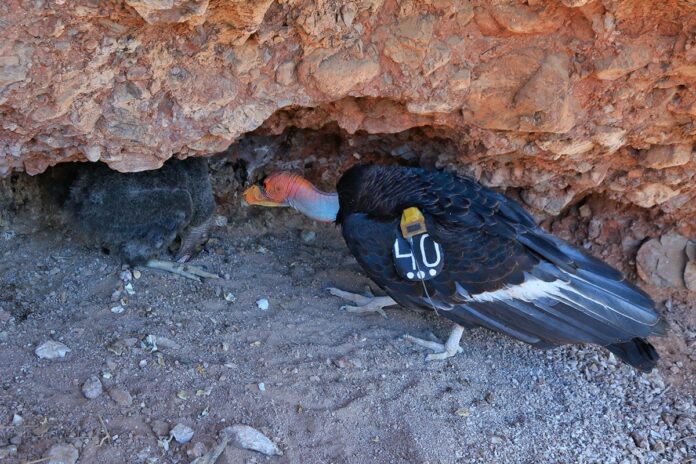An endangered female California condor chick took flight from a nest this week in Pinnacles National Park for the first time in more than 100 years.
According to Pinnacles National Park in a statement:
The historic flight was under close watch of her parents, both of whom were released into the wild through a partnership between the National Park Service and Ventana Wildlife Society.
Volunteers and staff have been observing the nest, found in a remote location in the Park, since her parents started incubating the egg in February. The five-and- a-half month old chick, known as condor #828, captured the attention of park biologists when she left the nest one month earlier than expected
“Condors nesting in the wild and surviving on their own is what it’s all about and this is yet another milestone towards that goal,” said Kelly Sorenson, executive director of the Ventana Wildlife Society, which first initiated condor releases in central California in 1997. The federal government and conservation groups have dedicated considerable resources to the restoration of the condor population that was brought to the brink of extinction in the 1980s.
“The young condor’s flight from the nest gives us a strong sense of hope,” said Karen Beppler-Dorn, superintendent of Pinnacles National Park. “However, our hope is tempered by the challenges that still exist for her and all wild condors.”
Lead poisoning continues to hinder recovery of this iconic species that so many people across the west have learned about and followed since the 1980s, when California condors nearly went extinct. With leadership from the US Fish and Wildlife Service, over thirty organizations and agencies have been committed to saving the species. Condors become ill and die when they inadvertently ingest fragments of lead ammunition in carcasses they feed upon that are left over from hunting or ranching operations.
“Condors and other scavenging wildlife, such as eagles, benefit from carcass remains left behind if non- lead ammunition is used. Hunters and ranchers have a long-standing tradition of wildlife conservation,” said Karen Beppler-Dorn.
“Shooters who have switched to non-lead ammunition have made an invaluable contribution to the health of all scavenging wildlife,” said Kelly Sorenson.
With continuing threats to their survival and recovery, volunteers with Pinnacles National Park’s Condor Program and Pinnacles Partnership–the Park’s non-profit Friends Group–help monitor condors, including watching the nest in the Park. Their dedication represents their passion for nature and commitment as stewards to the National Park Service.
“Volunteers contribute so much to monitoring and protecting wildlife in the Park, particularly the condors. They are some of the most committed people I have ever had the pleasure to work with” says Jenn Westphal, executive director of Pinnacles Partnership.




